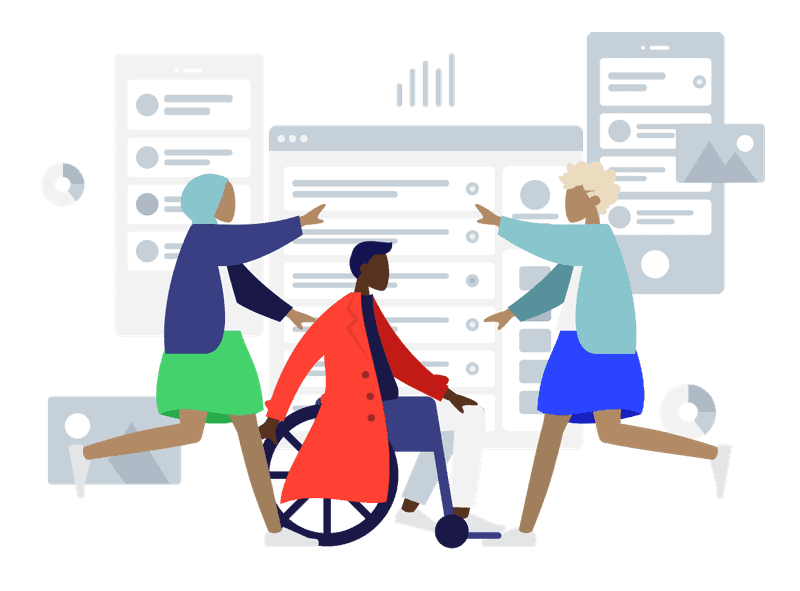In today’s digital landscape, ensuring that content is accessible to all users is not only a matter of inclusion but also a legal and ethical obligation. Addressing accessibility challenges makes it possible for people with disabilities to engage with digital content, fostering an inclusive online experience. By implementing solutions to these challenges, businesses and content creators can expand their audience, comply with regulations, and promote equal access for everyone. In this article, we’ll explore our top 10 strategies for overcoming common accessibility challenges and improving digital inclusivity.
Understanding Accessibility Challenges
Accessibility challenges refer to the barriers that prevent individuals with disabilities from fully accessing digital content. These challenges can stem from visual, auditory, motor, or cognitive impairments. For example, a person with a visual impairment might struggle to navigate a website that lacks screen reader compatibility, while someone with a motor disability might have difficulty interacting with content that requires mouse-only navigation. Adhering to established standards, such as the Web Content Accessibility Guidelines (WCAG) and the Americans with Disabilities Act (ADA), is crucial for creating accessible digital content. By following these guidelines, content creators can remove barriers and ensure their platforms are usable for everyone.

Top 10 Strategies for Addressing Common Accessibility Challenges
Clear and Simple Language
Using plain language is a foundational accessibility strategy. Complex vocabulary, jargon, and convoluted sentence structures can make content difficult to understand for many users, including those with cognitive disabilities. Content should be written in clear, straightforward language, using short sentences and familiar words. This ensures that the message is comprehensible to a broad audience, including individuals who may not be native speakers or who have reading difficulties.
Proper Use of Headings
Organizing content with proper headings (H1, H2, H3, etc.) is essential for both readability and accessibility. Descriptive headings help structure content, making it easier for all users to scan and understand. For users who rely on screen readers, headings provide navigational markers, enabling them to jump quickly between sections. Ensuring that headings follow a logical order helps create a seamless experience for all users.
Alt Text for Images
Alternative text (alt text) is a critical element of web accessibility. Alt text provides a description of images for users who rely on screen readers, allowing them to understand the content and context of the image. When writing alt text, it’s important to convey the purpose of the image, rather than just describing it. For example, instead of saying “image of a dog,” a more informative alt text might be “a guide dog helping a person navigate a crosswalk.”
Ensuring Color Contrast
Color contrast plays a significant role in text readability, particularly for users with visual impairments or color blindness. Following the WCAG-recommended contrast ratios between text and background ensures that content is legible for everyone. For instance, a contrast ratio of at least 4.5:1 is required for normal text. Online tools can help verify whether your color schemes meet these contrast standards, which is essential for maintaining accessibility.
Keyboard Accessibility
Not all users navigate websites using a mouse; some rely on keyboard navigation due to physical disabilities. Therefore, it’s crucial to ensure that all interactive elements, such as links, buttons, and form fields, are accessible via the keyboard. This includes enabling users to navigate through a site using the “Tab” key and ensuring that there are visual cues (such as focus states) to indicate which element is currently selected.
Accessible Forms
Forms are a key part of many websites, but they can pose significant challenges for users with disabilities. To improve form accessibility, it’s important to clearly label each form field and provide instructions where necessary. Additionally, forms should be designed to work seamlessly with screen readers and other assistive technologies. For example, using “aria-labels” can provide additional context to form fields, ensuring that all users can complete them accurately.
Captions and Transcripts for Multimedia
Videos and audio content are increasingly common on websites, but they can be inaccessible to users with hearing impairments unless captions and transcripts are provided. Captions offer a text alternative to the spoken content in videos, while transcripts provide a complete textual version of the audio content. Additionally, it’s important to ensure that multimedia players themselves are accessible, offering controls that can be operated with assistive technologies.
Descriptive Link Text
Link text should always be descriptive and clearly indicate the destination or purpose of the link. Vague phrases like “click here” or “read more” do not provide enough information for users who rely on screen readers. Instead, opt for descriptive link text such as “Learn more about our accessibility services.” This provides context and ensures that all users can easily understand the link’s purpose.
Consistent Navigation
Maintaining a consistent navigation structure across your website helps users, especially those with cognitive or motor disabilities, to navigate more easily. Clear labels, logical menus, and consistent placement of navigation elements allow users to quickly become familiar with your site’s structure. This consistency reduces confusion and increases the overall accessibility of your site.
Testing and Validation
Finally, regularly testing your content for accessibility is crucial to ensuring ongoing compliance with accessibility standards. Automated tools, such as screen readers, color contrast analyzers, and accessibility checkers, can identify many issues. However, manual testing with real users who rely on assistive technologies is equally important for validating the accessibility of your content in real-world scenarios.

Tools and Resources for Accessibility
A wide range of tools is available to help tackle accessibility challenges. Screen readers, such as NVDA and JAWS, allow you to test your content’s compatibility for visually impaired users. Tools like the WebAIM Contrast Checker ensure your website meets WCAG’s color contrast requirements, improving text readability. Accessibility checkers, such as WAVE and various third-party plugins, provide valuable insights into potential issues, making it easier to keep your site accessible. Additionally, Grackle products like Grackle Scan, Stream, Workspace, and PDF support accessibility improvements for both web and document formats.
Conclusion
Addressing accessibility challenges is an ongoing process that requires attention to detail and a commitment to inclusivity. By implementing the strategies outlined above, you can ensure that your digital content is accessible to all users. Remember, the key to overcoming accessibility barriers is continuous learning, testing, and improvement. By taking these steps, you contribute to a more inclusive and equitable digital environment for everyone. Please reach out to a member of our team today to learn more!


